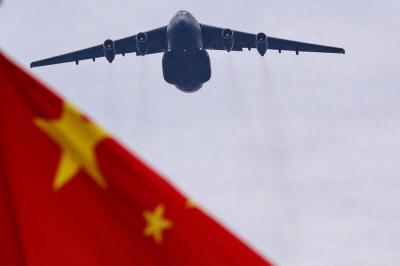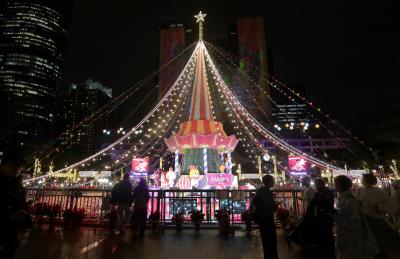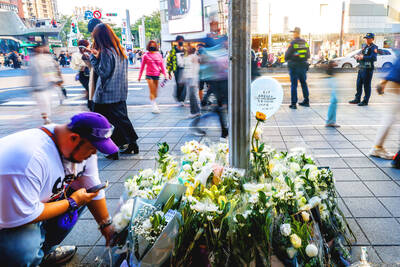EVA Airways and the Taoyuan Flight Attendants’ Union on Friday failed to reach common ground during talks over flight attendant pay and work hours, as well as corporate governance issues, with both sides accusing each other of acting in bad faith.
After the meeting, which was delayed by two hours due to squabbling over whether it should be broadcast live, the union said the airline addressed few of its demands.
The management’s proposals were basically the same as those discussed during the previous round of negotiations last month, which broke down and prompted a vote on whether EVA flight attendants should go on strike, a union representative said.
Despite the disappointing outcome, the two sides agreed to meet again on Wednesday.
EVA refused to raise flight attendants overseas allowances from NT$90 per hour to NT$150 per hour, union deputy secretary-general Chou Sheng-kai (周聖凱) said.
The airline was also reluctant to adjust the operations of nine round-trip flights that the union sees as “overwork flights,” Chou said.
The flight duty period on those flights often exceeds 12 hours, the maximum allowed in a single shift under the Labor Standards Act (勞動基準法), he said, adding that the union wants flight attendants to have more rest.
To avoid fatigue, the union is asking that flight crews work only one way on those routes and rest overnight rather than working both legs of a round-trip flight on the same day.
Among the routes cited were flights connecting Taiwan to Tokyo, Phnom Penh, Ho Chi Minh City, Beijing, Harbin, Shenyang and Hohhot, but EVA Airways was only willing to show flexibility on some flights, Chou said.
The union is mostly concerned about flights between Taiwan and Tokyo, Beijing and Phnom Penh because they account for more than half of the overwork flights, it has said previously.
EVA did agree to try the union’s proposal on a trial basis for one of the flights between Taiwan Taoyuan International Airport and Tokyo’s Narita International Airport and one between Taoyuan and Beijing, Chou said, adding that it would be subject to seasonal considerations.
For flights to and from Phnom Penh, the carrier agreed that flight attendants could voluntarily choose to fly only that route during a particular month in exchange for more days off.
“We had already tentatively agreed on those particular flights in our April meeting — a result that was far from our expectations, which is why we brought the whole package to the table again,” he said.
On corporate governance, EVA agreed that there could be union representatives included on its committee that evaluates employee performance, but it refused to grant them the right to participate in discussions or vote, Chou said.
EVA also did not accept the union’s appeal to introduce either an independent director or similar positions to better protect labor rights, he said.
EVA Air said in a statement that most employee benefits being challenged by the union are already better than at other airlines.
It said it is willing to consider giving flight attendants greater benefits, but refused the “no free ride” proposal by the union, saying that it would result in unequal treatment for flight attendants.
The “no free ride” proposal refers to the union’s demand that only union members be given the higher hourly overseas allowances they want, while non-union members would not be eligible.
The airline also said that the idea would jeopardize flight safety and quality of service.
On the issues involving corporate governance, EVA Air said that changes could be problematic because they contravene the company’s operating framework established by its shareholders, and would require further discussions.
Meanwhile, union secretary-general Cheng Ya-ling (鄭雅菱) said that it has already collected votes from 80 percent of its 3,200 EVA members.
For the vote to go on strike to pass, the union has said it would require backing from 80 percent of EVA Airways union members and the approval of more than half of the union’s 5,930 members who work for EVA, China Airlines or other smaller carriers.
The vote for EVA flight attendants ends today. Members from other airlines have until June 6 to vote.

Beijing could eventually see a full amphibious invasion of Taiwan as the only "prudent" way to bring about unification, the US Department of Defense said in a newly released annual report to Congress. The Pentagon's "Annual Report to Congress: Military and Security Developments Involving the People's Republic of China 2025," was in many ways similar to last year’s report but reorganized the analysis of the options China has to take over Taiwan. Generally, according to the report, Chinese leaders view the People's Liberation Army's (PLA) capabilities for a Taiwan campaign as improving, but they remain uncertain about its readiness to successfully seize

Taiwan is getting a day off on Christmas for the first time in 25 years. The change comes after opposition parties passed a law earlier this year to add or restore five public holidays, including Constitution Day, which falls on today, Dec. 25. The day marks the 1947 adoption of the constitution of the Republic of China, as the government in Taipei is formally known. Back then the Chinese Nationalist Party (KMT) governed China from Nanjing. When the KMT, now an opposition party in Taiwan, passed the legislation on holidays, it said that they would help “commemorate the history of national development.” That

Taiwan has overtaken South Korea this year in per capita income for the first time in 23 years, IMF data showed. Per capita income is a nation’s GDP divided by the total population, used to compare average wealth levels across countries. Taiwan also beat Japan this year on per capita income, after surpassing it for the first time last year, US magazine Newsweek reported yesterday. Across Asia, Taiwan ranked fourth for per capita income at US$37,827 this year due to sustained economic growth, the report said. In the top three spots were Singapore, Macau and Hong Kong, it said. South

HORROR STORIES: One victim recounted not realizing they had been stabbed and seeing people bleeding, while another recalled breaking down in tears after fleeing A man on Friday died after he tried to fight the knife-wielding suspect who went on a stabbing spree near two of Taipei’s busiest metro stations, Taipei Mayor Chiang Wan-an (蔣萬安) said. The 57-year-old man, identified by his family name, Yu (余), encountered the suspect at Exit M7 of Taipei Main Station and immediately tried to stop him, but was fatally wounded and later died, Chiang said, calling the incident “heartbreaking.” Yu’s family would receive at least NT$5 million (US$158,584) in compensation through the Taipei Rapid Transit Corp’s (TRTC) insurance coverage, he said after convening an emergency security response meeting yesterday morning. National